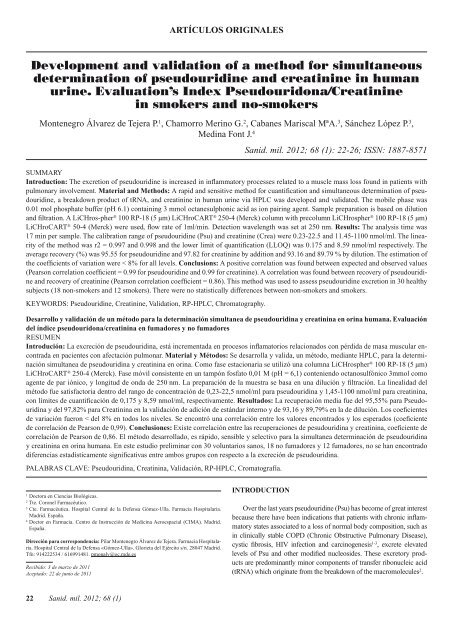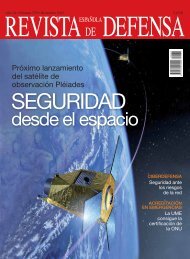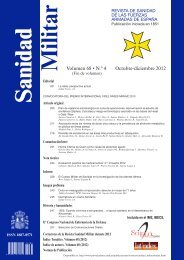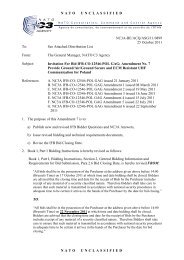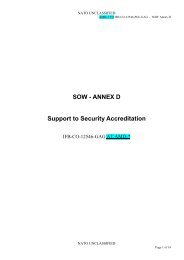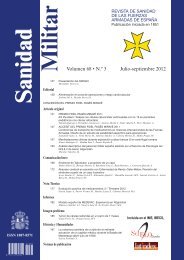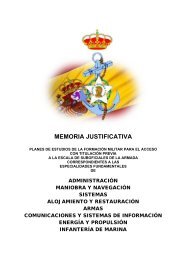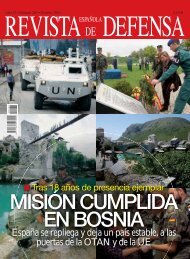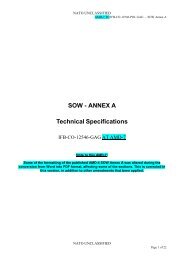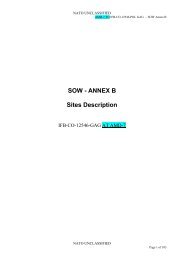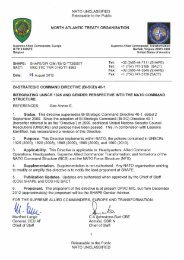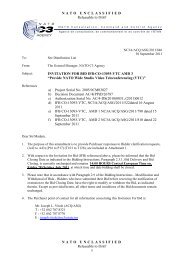Sanidad Militar - Ministerio de Defensa
Sanidad Militar - Ministerio de Defensa
Sanidad Militar - Ministerio de Defensa
Create successful ePaper yourself
Turn your PDF publications into a flip-book with our unique Google optimized e-Paper software.
ARTÍCULOS ORIGINALES<br />
Development and validation of a method for simultaneous<br />
<strong>de</strong>termination of pseudouridine and creatinine in human<br />
urine. Evaluation’s In<strong>de</strong>x Pseudouridona/Creatinine<br />
in smokers and no-smokers<br />
Montenegro Álvarez <strong>de</strong> Tejera P. 1 , Chamorro Merino G. 2 , Cabanes Mariscal MªA. 3 , Sánchez López P. 3 ,<br />
Medina Font J. 4<br />
Sanid. mil. 2012; 68 (1): 22-26; ISSN: 1887-8571<br />
SUMMARY<br />
Introduction: The excretion of pseudouridine is increased in inflammatory processes related to a muscle mass loss found in patients with<br />
pulmonary involvement. Material and Methods: A rapid and sensitive method for cuantification and simultaneous <strong>de</strong>termination of pseudouridine,<br />
a breakdown product of tRNA, and creatinine in human urine via HPLC was <strong>de</strong>veloped and validated. The mobile phase was<br />
0.01 mol phosphate buffer (pH 6.1) containing 3 mmol octanesulphonic acid as ion pairing agent. Sample preparation is based on dilution<br />
and filtration. A LiCHros-pher ® 100 RP-18 (5 µm) LiCHroCART ® 250-4 (Merck) column with precolumn LiCHrospher ® 100 RP-18 (5 µm)<br />
LiCHroCART ® 50-4 (Merck) were used, flow rate of 1ml/min. Detection wavelength was set at 250 nm. Results: The analysis time was<br />
17 min per sample. The calibration range of pseudouridine (Psu) and creatinine (Crea) were 0.23-22.5 and 11.45-1100 nmol/ml. The linearity<br />
of the method was r2 = 0.997 and 0.998 and the lower limit of quantification (LLOQ) was 0.175 and 8.59 nmol/ml respectively. The<br />
average recovery (%) was 95.55 for pseudouridine and 97.82 for creatinine by addition and 93.16 and 89.79 % by dilution. The estimation of<br />
the coefficients of variation were < 8% for all levels. Conclusions: A positive correlation was found between expected and observed values<br />
(Pearson correlation coefficient = 0.99 for pseudouridine and 0.99 for creatinine). A correlation was found between recovery of pseudouridine<br />
and recovery of creatinine (Pearson correlation coefficient = 0.86). This method was used to assess pseudouridine excretion in 30 healthy<br />
subjects (18 non-smokers and 12 smokers). There were no statistically differences between non-smokers and smokers.<br />
KEYWORDS: Pseudouridine, Creatinine, Validation, RP-HPLC, Chromatography.<br />
Desarrollo y validación <strong>de</strong> un método para la <strong>de</strong>terminación simultanea <strong>de</strong> pseudouridina y creatinina en orina humana. Evaluación<br />
<strong>de</strong>l índice pseudouridona/creatinina en fumadores y no fumadores<br />
RESUMEN<br />
Introdución: La excreción <strong>de</strong> pseudouridina, está incrementada en procesos inflamatorios relacionados con pérdida <strong>de</strong> masa muscular encontrada<br />
en pacientes con afectación pulmonar. Material y Métodos: Se <strong>de</strong>sarrolla y valida, un método, mediante HPLC, para la <strong>de</strong>terminación<br />
simultanea <strong>de</strong> pseudouridina y creatinina en orina. Como fase estacionaria se utilizó una columna LiCHrospher ® 100 RP-18 (5 µm)<br />
LiCHroCART ® 250-4 (Merck). Fase móvil consistente en un tampón fosfato 0,01 M (pH = 6,1) conteniendo octanosulfónico 3mmol como<br />
agente <strong>de</strong> par iónico, y longitud <strong>de</strong> onda <strong>de</strong> 250 nm. La preparación <strong>de</strong> la muestra se basa en una dilución y filtración. La linealidad <strong>de</strong>l<br />
método fue satisfactoria <strong>de</strong>ntro <strong>de</strong>l rango <strong>de</strong> concentración <strong>de</strong> 0,23-22,5 nmol/ml para pseudouridina y 1,45-1100 nmol/ml para creatinina,<br />
con límites <strong>de</strong> cuantificación <strong>de</strong> 0,175 y 8,59 nmol/ml, respectivamente. Resultados: La recuperación media fue <strong>de</strong>l 95,55% para Pseudouridina<br />
y <strong>de</strong>l 97,82% para Creatinina en la validación <strong>de</strong> adición <strong>de</strong> estándar interno y <strong>de</strong> 93,16 y 89,79% en la <strong>de</strong> dilución. Los coeficientes<br />
<strong>de</strong> variación fueron < <strong>de</strong>l 8% en todos los niveles. Se encontró una correlación entre los valores encontrados y los esperados (coeficiente<br />
<strong>de</strong> correlación <strong>de</strong> Pearson <strong>de</strong> 0,99). Conclusiones: Existe correlación entre las recuperaciones <strong>de</strong> pesudouridina y creatinina, coeficiente <strong>de</strong><br />
correlación <strong>de</strong> Pearson <strong>de</strong> 0,86. El método <strong>de</strong>sarrollado, es rápido, sensible y selectivo para la simultanea <strong>de</strong>terminación <strong>de</strong> pseudouridina<br />
y creatinina en orina humana. En este estudio preliminar con 30 voluntarios sanos, 18 no fumadores y 12 fumadores, no se han encontrado<br />
diferencias estadísticamente significativas entre ambos grupos con respecto a la excreción <strong>de</strong> pseudouridina.<br />
PALABRAS CLAVE: Pseudouridina, Creatinina, Validación, RP-HPLC, Cromatografía.<br />
1<br />
Doctora en Ciencias Biológicas.<br />
2<br />
Tte. Coronel Farmacéutico.<br />
3 <br />
Cte. Farmacéutica. Hospital Central <strong>de</strong> la <strong>Defensa</strong> Gómez-Ulla. Farmacia Hospitalaria.<br />
Madrid. España.<br />
4 <br />
Doctor en Farmacia. Centro <strong>de</strong> Instrucción <strong>de</strong> Medicina Aeroespacial (CIMA). Madrid.<br />
España.<br />
Dirección para correspon<strong>de</strong>ncia: Pilar Montenegro Álvarez <strong>de</strong> Tejera. Farmacia Hospitalaria.<br />
Hospital Central <strong>de</strong> la <strong>Defensa</strong> «Gómez-Ulla». Glorieta <strong>de</strong>l Ejército s/n. 28047 Madrid.<br />
Tfn: 914222534 / 616991481. pmonalv@oc.m<strong>de</strong>.es<br />
Recibido: 3 <strong>de</strong> marzo <strong>de</strong> 2011<br />
Aceptado: 22 <strong>de</strong> junio <strong>de</strong> 2011<br />
INTRODUCTION<br />
Over the last years pseudouridine (Psu) has become of great interest<br />
because there have been indications that patients with chronic inflammatory<br />
states associated to a loss of normal body composition, such as<br />
in clinically stable COPD (Chronic Obstructive Pulmonary Disease),<br />
cystic fibrosis, HIV infection and carcinogenesis 1-3 , excrete elevated<br />
levels of Psu and other modified nucleosi<strong>de</strong>s. These excretory products<br />
are predominantly minor components of transfer ribonucleic acid<br />
(tRNA) which originate from the breakdown of the macromolecules 2 .<br />
22 Sanid. mil. 2012; 68 (1)


